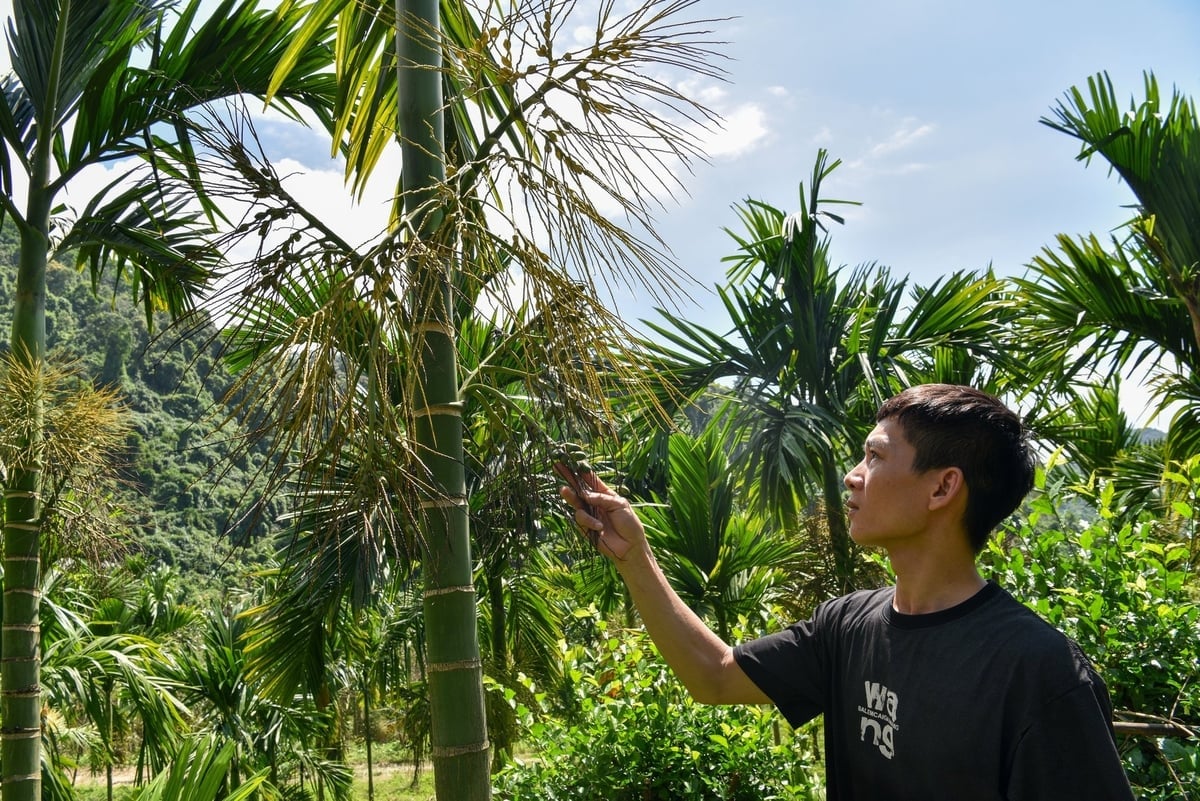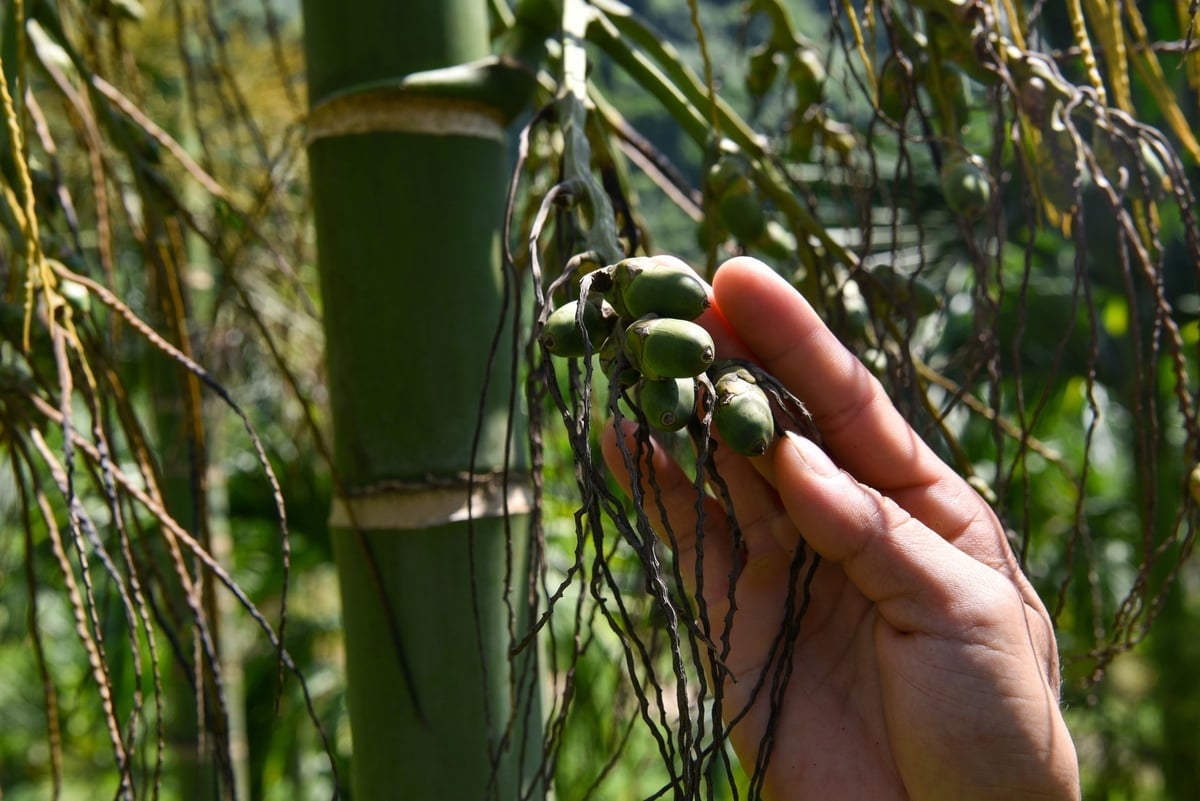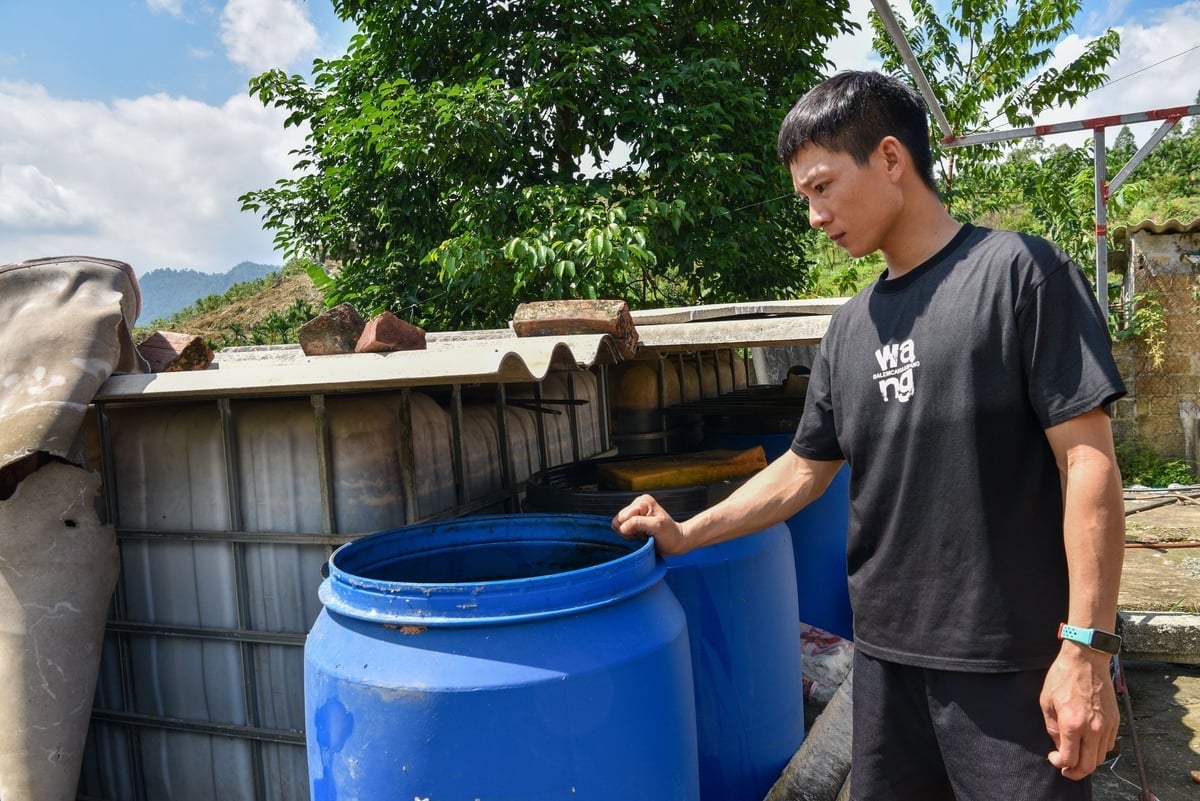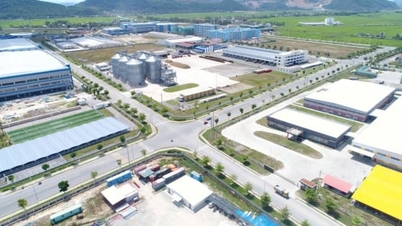Harvest the fruit when it is as big as your index finger.
Their faces suddenly lit up with vitality, their eyes sharper than areca knives. When asked, we learned that this type of areca nut, when eaten whole and young, contains a lot of water, is soft, sweet, and creates a feeling of excitement, completely different from the areca nut variety in Vietnam, even when picked young, has little water, is hard, and has a lot of fibers. About 2 million Taiwanese people, mainly men, are addicted to betel chewing, although scientists recommend giving up this custom because it can cause oral cancer...

Mr. Nguyen Van Huong is checking Taiwanese areca bunches ready for harvest. Photo: Duong Dinh Tuong.
When I heard that in Don hamlet, old Tan Minh commune (now Van Mieu commune, Phu Tho province) there was a Taiwanese areca farm growing to serve Taiwanese people living in Vietnam and for export, I immediately found my way there to satisfy my curiosity.
Mr. Nguyen Van Huong - the farm manager led me through the cool shade of the big areca trees, the young areca trees spread out like the tail of a dancing male peacock. Surrounding the areca garden is a cool green protective forest and a waterfall pouring white across the sky.
Picking two young areca nuts about the size of an index finger, he put one in his mouth and chewed it deliciously, then offered the other to me. After a moment of hesitation, I tried chewing it. It was soft, sweet, and intoxicating, causing my face to suddenly feel hot, my heart to beat faster, and a little queasy in my stomach.
“If you roll betel leaves with a little lime around the areca nut, it will taste even better. Taiwanese people chew betel nut continuously like Vietnamese people smoke, eating several packs a day, each pack contains 10 areca nuts inside, the price is expensive so in Vietnamese currency, some people can spend several million dong,” Mr. Huong introduced. I pointed to a pile of young areca nuts the size of a thumb scattered around an areca tree and asked him, he explained that those are old and not good enough to eat, so they are spread around the tree to be used as fertilizer.
Mr. Huong's mother-in-law was from Dan Phuong, Hanoi . Later, she went to Taiwan and married a local man who grew areca nuts. They did very well in business. Taiwan's terrain is mostly mountainous, very suitable for growing areca nuts. Therefore, when someone introduced him to this 20-hectare hilly land at an altitude of more than 240m, his father-in-law was very interested.

Areca nuts as small as a finger can be harvested. Photo: Duong Dinh Tuong.
“He has been growing areca nuts in Taiwan for decades. I don’t know the exact area of the garden there, but I only know that it is very large. In 2016, he rented land here but couldn’t plant them right away. He had to order areca nuts and send them to his wife’s hometown, Dan Phuong, to grow them. He only brought them up when the trees were about 1 meter tall. I have now planted about 4 hectares and am still growing 20,000 seedlings so that when the weather cools down at the end of the year, we can continue to expand the area,” Mr. Huong continued.
Fertilize with bananas, eggs, milk, and salt.
Mr. Huong's parents-in-law still live in Taiwan, and only return to Vietnam a few times a year, so the entire farm is managed by him, who cultivates it directly with one worker. During the harvest season, they hire 2-3 more workers. While mainland Chinese people like to eat areca candy made from quite mature areca nuts, seasoned with sugar and some spices, Taiwanese people only like to eat young areca nuts with a betel leaf and a little lime. According to Mr. Huong, the very steep areas in the farm are paved and planted along the contour lines, while the slightly steep areas are left as they are and planted with a density of 2m between rows and 2m between trees.
When planting areca on the hill, the most difficult time is when the seeds are first planted, it is easy to lack water, if not watered, the tree will die young, losing an average of 10 - 15%. Once the tree has grown, it is quite easy, no need to water regularly. Areca has strong resistance, almost no pests, so it rarely needs to be sprayed with pesticides, and when the grass is higher than the knee, it is cut with a machine. The soil and climate in the mountainous area make the areca fruit much more delicious than those grown in the plains.
Because the fruit is harvested when it is still young, the tree does not lose strength, and only needs to be fertilized twice a year, NPK fertilizer at the beginning of the year, chicken manure at the end of the year, and about 100-200 grams of salt sprinkled on each tree. In addition, Mr. Huong also soaks fish, eggs, bananas, and milk in water and mixes it with water to water the tree monthly to make the fruit more delicious and sweet.

Areca palms are planted in overlapping rows 5 years apart so that if they get too tall they can still be harvested if they are cut down. Photo: Duong Dinh Tuong.
Taiwanese areca trees, if well cared for, will bear fruit after 4 years, but not after 5 years, the fruit is not even at this time, the yield is not stable. In the 6th year, like in Mr. Huong's farm, 80% of the trees have already produced fruit. Areca trees have a lifespan of about 30 - 40 years but are planted in overlapping layers, each layer is 5 years apart, when they are too tall and difficult to harvest, they will be cut down and the shorter trees will be picked.
Taiwanese areca palms flower in the summer, and by October the first bunches are harvested, and then the bunches continue to be picked until April or May of the following year. On average, each tree yields 3-4 bunches, each bunch has 150-200 fruits. When buying, people do not calculate by weight but by fruit, just count the fruits to calculate the price, the price fluctuates from batch to batch, from 1,000-2,000 VND/fruit.
Areca nuts are harvested with a sickle tied to a pole and then lowered, each fruit is cut off, kept cold, transported fresh to Hanoi and then sent to provinces and cities to serve Taiwanese and mainland Chinese living in Vietnam, and also exported to Thailand, Cambodia, Laos... Because it is the first crop, the farm's revenue is still modest, reaching about 500 million VND, of which the cost is about 100 million VND.

Barrels of eggs, milk, and bananas to water the areca trees. Photo: Duong Dinh Tuong.
I asked Mr. Huong if he had any advice for those who intend to grow Taiwanese areca? Without hiding anything, he immediately answered that in Vietnam, the number of Taiwanese areca farms can be counted on the fingers because it is not only related to the variety but more importantly, the output. It is a rather narrow niche market, there must be a consumption contract before planting, otherwise the product cannot be exported to China to make areca candy, nor can it be sold in the domestic market because it is a different variety that is still in use.
The habit of chewing betel and areca nuts has existed for thousands of years in Taiwan. During the Japanese colonial period, this habit was further promoted by the government's encouragement that chewing betel and areca nuts could cure jaundice. In later years, areca nuts were a popular and highly valuable crop, ranking second only to rice in Taiwan.
Source: https://nongnghiepmoitruong.vn/trong-giong-cau-phuc-vu-nguoi-dai-loan-o-viet-nam-d776845.html


![[Photo] Ca Mau "struggling" to cope with the highest tide of the year, forecast to exceed alert level 3](https://vphoto.vietnam.vn/thumb/1200x675/vietnam/resource/IMAGE/2025/11/04/1762235371445_ndo_br_trieu-cuong-2-6486-jpg.webp)
![[Photo] The road connecting Dong Nai with Ho Chi Minh City is still unfinished after 5 years of construction.](https://vphoto.vietnam.vn/thumb/1200x675/vietnam/resource/IMAGE/2025/11/04/1762241675985_ndo_br_dji-20251104104418-0635-d-resize-1295-jpg.webp)

![[Photo] Panorama of the Patriotic Emulation Congress of Nhan Dan Newspaper for the period 2025-2030](https://vphoto.vietnam.vn/thumb/1200x675/vietnam/resource/IMAGE/2025/11/04/1762252775462_ndo_br_dhthiduayeuncbaond-6125-jpg.webp)
![[Photo] Ho Chi Minh City Youth Take Action for a Cleaner Environment](https://vphoto.vietnam.vn/thumb/1200x675/vietnam/resource/IMAGE/2025/11/04/1762233574890_550816358-1108586934787014-6430522970717297480-n-1-jpg.webp)














![Veterinary vaccine story: [Part 1] Trust from healthy ducks](https://vphoto.vietnam.vn/thumb/402x226/vietnam/resource/IMAGE/2025/11/04/1762242604682_0249-dsc09461-145316_229.jpeg)


















































































Comment (0)